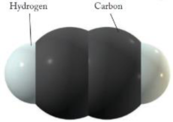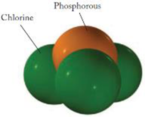
Chemistry Principles And Practice
3rd Edition
ISBN: 9781305295803
Author: David Reger; Scott Ball; Daniel Goode
Publisher: Cengage Learning
expand_more
expand_more
format_list_bulleted
Question
Chapter 2, Problem 2.70QE
(a)
Interpretation Introduction
Interpretation:
Molecular formula for the given diagram has to be written.

Concept Introduction:
Molecular formula is a simple representation of a compound using the atomic symbols of the constituent elements present in it. In molecular formula, the subscript after the atomic symbol represent the number of atoms of the same element is present in the compound.
(b)
Interpretation Introduction
Interpretation:
Molecular formula for the given diagram has to be written.

Concept Introduction:
Refer part (a).
Expert Solution & Answer
Trending nowThis is a popular solution!

Students have asked these similar questions
Feedback: Your answer is incorrect.
Predict the major products of the following organic reaction:
CN
Δ
+
A ?
NC
Some important notes:
• Draw the major product, or products, of the reaction in the drawing area below.
• If there aren't any products, because no reaction will take place, check the box below the drawing area instead.
• Be sure to use wedge and dash bonds when necessary, for example to distinguish between major products that are enantiomers.
esc
Check
80
MH
F1
F2
F3
F4
F5
50
@
# C
%
95
€
Save For Later
Sub
2025 McGraw Hill LLC. All Rights Reserved. Terms of Use | Privacy C
A
DII
F6
F7
F8
7
*
8
Λ
&
6
F9
F10
9
0
4
Incorrect
Feedback: Your answer is incorrect.
Predict the major products of the following organic reaction:
ཤིགས་བྱ རྩ་ཅད་ཀྱིས་༢༩
+
Some important notes:
A
^ ?
• Draw the major product, or products, of the reaction in the drawing area below.
• If there aren't any products, because no reaction will take place, check the box below the drawing area instead.
• Be sure to use wedge and dash bonds when necessary, for example to distinguish between major products that are enantiomers.
E
Check
0
لا
Save For La
©2025 McGraw Hill LLC. All Rights Reserved. Terms of
All
F9
A
Predict the major products of the following organic reaction:
+
Δ
A ?
Some important notes:
• Draw the major product, or products, of the reaction in the drawing area below.
• If there aren't any products, because no reaction will take place, check the box below the drawing area instead.
• Be sure to use wedge and dash bonds when necessary, for example to distinguish between major products that are enantiomers.
Explanation
Check
Click and drag to start drawing a structure.
2025 McGraw Hill LLC. All Rights Reserved. Terms of Use
Priva
Chapter 2 Solutions
Chemistry Principles And Practice
Ch. 2 - Prob. 2.1QECh. 2 - State how Daltons atomic theory explains (a) the...Ch. 2 - Prob. 2.3QECh. 2 - Prob. 2.4QECh. 2 - Prob. 2.5QECh. 2 - Prob. 2.6QECh. 2 - Prob. 2.7QECh. 2 - Describe the arrangement of protons, neutrons, and...Ch. 2 - Prob. 2.9QECh. 2 - Prob. 2.10QE
Ch. 2 - A mass spectrometer determines isotopic masses to...Ch. 2 - Prob. 2.12QECh. 2 - Prob. 2.13QECh. 2 - Prob. 2.14QECh. 2 - Prob. 2.15QECh. 2 - Prob. 2.16QECh. 2 - Sulfur dioxide, SO2, is a molecular compound that...Ch. 2 - Prob. 2.18QECh. 2 - Prob. 2.19QECh. 2 - Prob. 2.20QECh. 2 - Prob. 2.21QECh. 2 - Prob. 2.22QECh. 2 - Prob. 2.23QECh. 2 - Prob. 2.24QECh. 2 - Prob. 2.25QECh. 2 - Prob. 2.26QECh. 2 - Prob. 2.27QECh. 2 - Prob. 2.28QECh. 2 - Prob. 2.29QECh. 2 - Give the complete symbol (XZA), including atomic...Ch. 2 - Prob. 2.31QECh. 2 - Prob. 2.32QECh. 2 - Prob. 2.33QECh. 2 - Prob. 2.34QECh. 2 - Prob. 2.35QECh. 2 - Prob. 2.36QECh. 2 - Prob. 2.37QECh. 2 - Prob. 2.38QECh. 2 - Prob. 2.39QECh. 2 - Prob. 2.40QECh. 2 - Prob. 2.41QECh. 2 - Prob. 2.42QECh. 2 - Prob. 2.43QECh. 2 - Prob. 2.44QECh. 2 - Prob. 2.45QECh. 2 - Prob. 2.46QECh. 2 - Prob. 2.47QECh. 2 - Prob. 2.48QECh. 2 - Prob. 2.49QECh. 2 - Prob. 2.50QECh. 2 - Prob. 2.51QECh. 2 - Prob. 2.52QECh. 2 - Prob. 2.53QECh. 2 - Prob. 2.54QECh. 2 - Prob. 2.55QECh. 2 - Prob. 2.56QECh. 2 - Prob. 2.57QECh. 2 - Prob. 2.58QECh. 2 - Prob. 2.59QECh. 2 - Prob. 2.60QECh. 2 - Prob. 2.61QECh. 2 - Prob. 2.62QECh. 2 - Prob. 2.63QECh. 2 - Prob. 2.64QECh. 2 - Prob. 2.65QECh. 2 - Prob. 2.66QECh. 2 - Prob. 2.67QECh. 2 - Prob. 2.68QECh. 2 - Prob. 2.69QECh. 2 - Prob. 2.70QECh. 2 - Prob. 2.71QECh. 2 - Prob. 2.72QECh. 2 - Prob. 2.73QECh. 2 - Prob. 2.74QECh. 2 - Prob. 2.75QECh. 2 - Prob. 2.76QECh. 2 - Prob. 2.77QECh. 2 - Prob. 2.78QECh. 2 - Prob. 2.79QECh. 2 - Prob. 2.80QECh. 2 - Prob. 2.81QECh. 2 - Prob. 2.82QECh. 2 - Prob. 2.83QECh. 2 - Prob. 2.84QECh. 2 - Prob. 2.85QECh. 2 - Prob. 2.86QECh. 2 - Prob. 2.87QECh. 2 - Prob. 2.88QECh. 2 - Prob. 2.89QECh. 2 - Prob. 2.90QECh. 2 - Prob. 2.91QECh. 2 - Prob. 2.92QECh. 2 - Prob. 2.93QECh. 2 - Prob. 2.94QECh. 2 - Prob. 2.95QECh. 2 - Prob. 2.96QECh. 2 - Write the formula of (a) manganese(III) sulfide....Ch. 2 - Prob. 2.98QECh. 2 - Prob. 2.99QECh. 2 - Prob. 2.100QECh. 2 - Prob. 2.101QECh. 2 - Prob. 2.102QECh. 2 - Prob. 2.103QECh. 2 - Prob. 2.104QECh. 2 - Prob. 2.105QECh. 2 - Prob. 2.106QECh. 2 - Prob. 2.107QECh. 2 - Prob. 2.108QECh. 2 - Prob. 2.109QECh. 2 - Prob. 2.110QECh. 2 - Prob. 2.111QECh. 2 - Prob. 2.112QECh. 2 - Prob. 2.113QECh. 2 - Prob. 2.114QECh. 2 - Prob. 2.115QECh. 2 - Prob. 2.116QECh. 2 - Prob. 2.117QECh. 2 - Prob. 2.118QECh. 2 - Prob. 2.119QECh. 2 - Prob. 2.120QECh. 2 - Prob. 2.121QECh. 2 - Prob. 2.122QECh. 2 - Prob. 2.123QECh. 2 - Prob. 2.124QECh. 2 - Prob. 2.125QECh. 2 - Prob. 2.126QECh. 2 - Prob. 2.127QECh. 2 - Prob. 2.128QECh. 2 - Prob. 2.129QECh. 2 - Prob. 2.130QECh. 2 - Prob. 2.131QECh. 2 - Prob. 2.132QECh. 2 - Prob. 2.133QECh. 2 - Prob. 2.134QECh. 2 - Prob. 2.135QECh. 2 - Prob. 2.136QE
Knowledge Booster
Learn more about
Need a deep-dive on the concept behind this application? Look no further. Learn more about this topic, chemistry and related others by exploring similar questions and additional content below.Similar questions
- esc 2 Incorrect Feedback: Your answer is incorrect. Can the molecule on the right-hand side of this organic reaction be made in good yield from no more than two reactants, in one step, by moderately heating the reactants? ? A O • If your answer is yes, then draw the reactant or reactants in the drawing area below. You can draw the reactants in any arrangement you like. . If your answer is no, check the box under the drawing area instead. Check F1 ! @ X C Save For Later Submit Assignment 2025 McGraw Hill LLC. All Rights Reserved. Terms of Use | Privacy Center | Accessibility 80 et A ད 1 4 F2 F3 F4 F5 F6 F7 F8 F9 F10 F11 F12 # $ 45 % A 6 87 & * 8 9 ) 0 + ||arrow_forwardCan the molecule on the right-hand side of this organic reaction be made in good yield from no more than two reactants, in one step, by moderately heating the reactants? ?A Δ O • If your answer is yes, then draw the reactant or reactants in the drawing area below. You can draw the reactants in any arrangement you like. • If your answer is no, check the box under the drawing area instead. Explanation Check Click and drag to start drawing a structure. 2025 McGraw Hill LLC. All Rights Reserved. Terms of Use | Privacy Center | Accessibilit ku F11arrow_forward१ eq ine teaching and × + rn/takeAssignment/takeCovalentActivity.do?locator-assignment-take [Review Topics] [References] Write an acceptable IUPAC name for the compound below. (Only systematic names, not common names are accepted by this question.) Keep the information page open for feedback reference. The IUPAC name is In progress mit Answer Retry Entire Group 5 more group attempts remaining Cengage Learning | Cengage Technical Support Save and Exitarrow_forward
- Draw the molecules.arrow_forwardDraw the mechanism for the acid-catalyzed dehydration of 2-methyl-hexan-2-ol with arrows please.arrow_forward. Draw the products for addition reactions (label as major or minor) of the reaction between 2-methyl-2-butene and with following reactants : Steps to follow : A. These are addition reactions you need to break a double bond and make two products if possible. B. As of Markovnikov rule the hydrogen should go to that double bond carbon which has more hydrogen to make stable products or major product. Here is the link for additional help : https://study.com/academy/answer/predict-the-major-and-minor-products-of-2-methyl- 2-butene-with-hbr-as-an-electrophilic-addition-reaction-include-the-intermediate- reactions.html H₂C CH3 H H3C CH3 2-methyl-2-butene CH3 Same structure CH3 IENCESarrow_forward
- Draw everything on a piece of paper including every single step and each name provided using carbons less than 3 please.arrow_forwardTopics] [References] Write an acceptable IUPAC name for the compound below. (Only systematic names, not common names are accepted by this question.) Keep the information page open for feedback reference. H The IUPAC name isarrow_forward[Review Topics] [References] Write an acceptable IUPAC name for the compound below. (Only systematic names, not common names are accepted by this question.) Keep the information page open for feedback reference. The IUPAC name is Submit Answer Retry Entire Group 9 more group attempts remainingarrow_forward
- Please draw.arrow_forwardA chromatogram with ideal Gaussian bands has tR = 9.0 minutes and w1/2 = 2.0 minutes. Find the number of theoretical plates that are present, and calculate the height of each theoretical plate if the column is 10 centimeters long.arrow_forwardAn open tubular column has an inner diameter of 207 micrometers, and the thickness of the stationary phase on the inner wall is 0.50 micrometers. Unretained solute passes through in 63 seconds and a particular solute emerges at 433 seconds. Find the distribution constant for this solute and find the fraction of time spent in the stationary phase.arrow_forward
arrow_back_ios
SEE MORE QUESTIONS
arrow_forward_ios
Recommended textbooks for you
 Chemistry: Principles and PracticeChemistryISBN:9780534420123Author:Daniel L. Reger, Scott R. Goode, David W. Ball, Edward MercerPublisher:Cengage Learning
Chemistry: Principles and PracticeChemistryISBN:9780534420123Author:Daniel L. Reger, Scott R. Goode, David W. Ball, Edward MercerPublisher:Cengage Learning Chemistry: The Molecular ScienceChemistryISBN:9781285199047Author:John W. Moore, Conrad L. StanitskiPublisher:Cengage Learning
Chemistry: The Molecular ScienceChemistryISBN:9781285199047Author:John W. Moore, Conrad L. StanitskiPublisher:Cengage Learning General Chemistry - Standalone book (MindTap Cour...ChemistryISBN:9781305580343Author:Steven D. Gammon, Ebbing, Darrell Ebbing, Steven D., Darrell; Gammon, Darrell Ebbing; Steven D. Gammon, Darrell D.; Gammon, Ebbing; Steven D. Gammon; DarrellPublisher:Cengage Learning
General Chemistry - Standalone book (MindTap Cour...ChemistryISBN:9781305580343Author:Steven D. Gammon, Ebbing, Darrell Ebbing, Steven D., Darrell; Gammon, Darrell Ebbing; Steven D. Gammon, Darrell D.; Gammon, Ebbing; Steven D. Gammon; DarrellPublisher:Cengage Learning Chemistry: Principles and ReactionsChemistryISBN:9781305079373Author:William L. Masterton, Cecile N. HurleyPublisher:Cengage Learning
Chemistry: Principles and ReactionsChemistryISBN:9781305079373Author:William L. Masterton, Cecile N. HurleyPublisher:Cengage Learning Introductory Chemistry: A FoundationChemistryISBN:9781337399425Author:Steven S. Zumdahl, Donald J. DeCostePublisher:Cengage Learning
Introductory Chemistry: A FoundationChemistryISBN:9781337399425Author:Steven S. Zumdahl, Donald J. DeCostePublisher:Cengage Learning Chemistry & Chemical ReactivityChemistryISBN:9781337399074Author:John C. Kotz, Paul M. Treichel, John Townsend, David TreichelPublisher:Cengage Learning
Chemistry & Chemical ReactivityChemistryISBN:9781337399074Author:John C. Kotz, Paul M. Treichel, John Townsend, David TreichelPublisher:Cengage Learning

Chemistry: Principles and Practice
Chemistry
ISBN:9780534420123
Author:Daniel L. Reger, Scott R. Goode, David W. Ball, Edward Mercer
Publisher:Cengage Learning

Chemistry: The Molecular Science
Chemistry
ISBN:9781285199047
Author:John W. Moore, Conrad L. Stanitski
Publisher:Cengage Learning

General Chemistry - Standalone book (MindTap Cour...
Chemistry
ISBN:9781305580343
Author:Steven D. Gammon, Ebbing, Darrell Ebbing, Steven D., Darrell; Gammon, Darrell Ebbing; Steven D. Gammon, Darrell D.; Gammon, Ebbing; Steven D. Gammon; Darrell
Publisher:Cengage Learning

Chemistry: Principles and Reactions
Chemistry
ISBN:9781305079373
Author:William L. Masterton, Cecile N. Hurley
Publisher:Cengage Learning

Introductory Chemistry: A Foundation
Chemistry
ISBN:9781337399425
Author:Steven S. Zumdahl, Donald J. DeCoste
Publisher:Cengage Learning

Chemistry & Chemical Reactivity
Chemistry
ISBN:9781337399074
Author:John C. Kotz, Paul M. Treichel, John Townsend, David Treichel
Publisher:Cengage Learning
GCSE Chemistry - Differences Between Compounds, Molecules & Mixtures #3; Author: Cognito;https://www.youtube.com/watch?v=jBDr0mHyc5M;License: Standard YouTube License, CC-BY